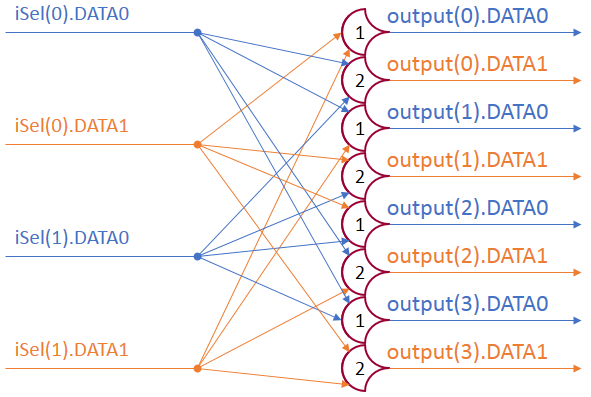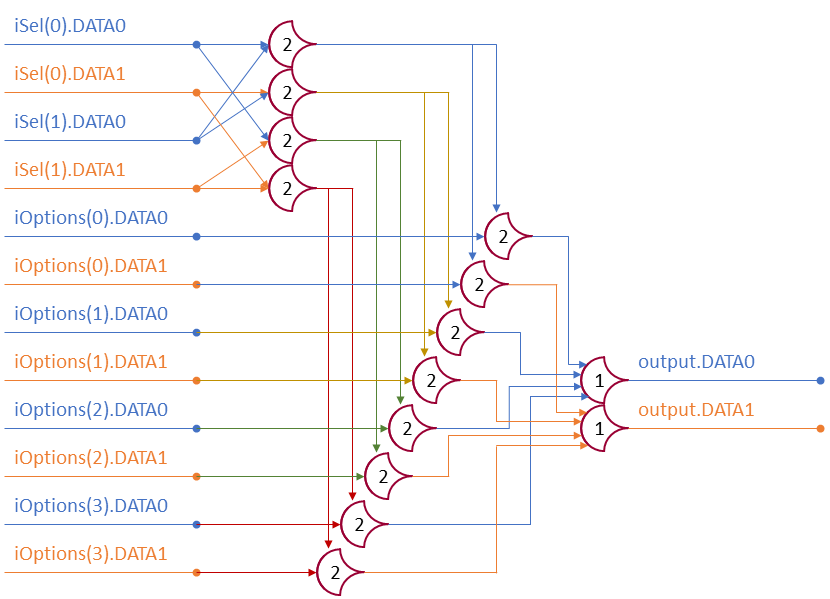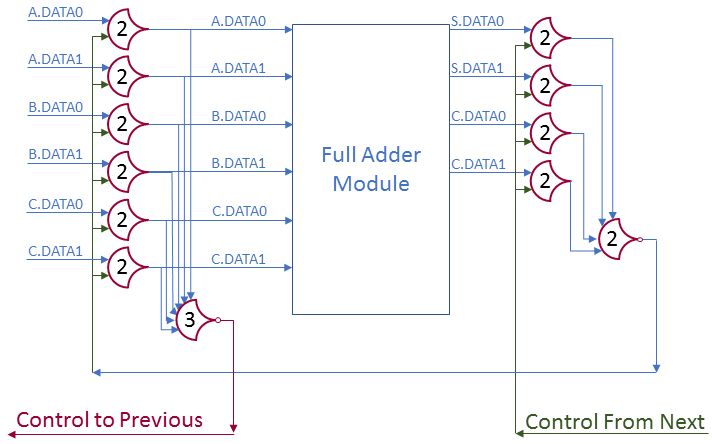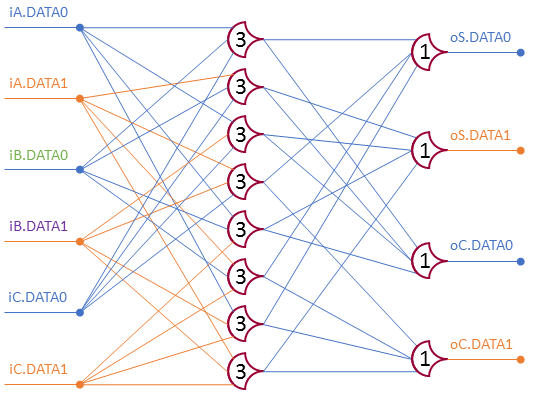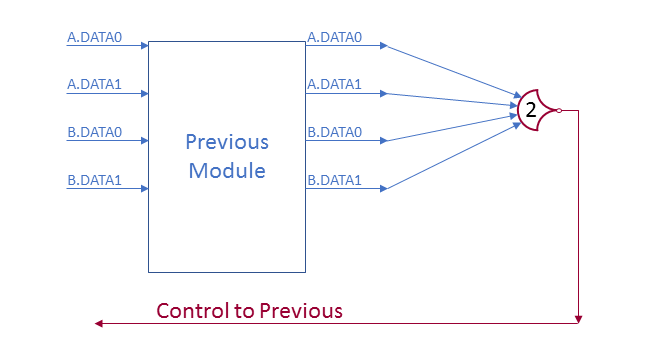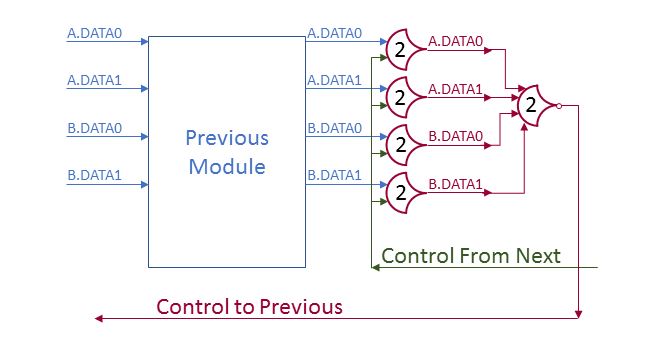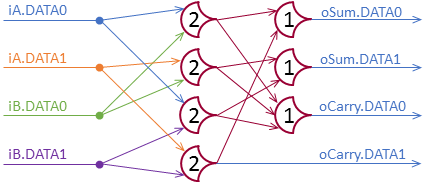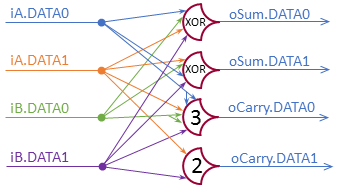Design Recap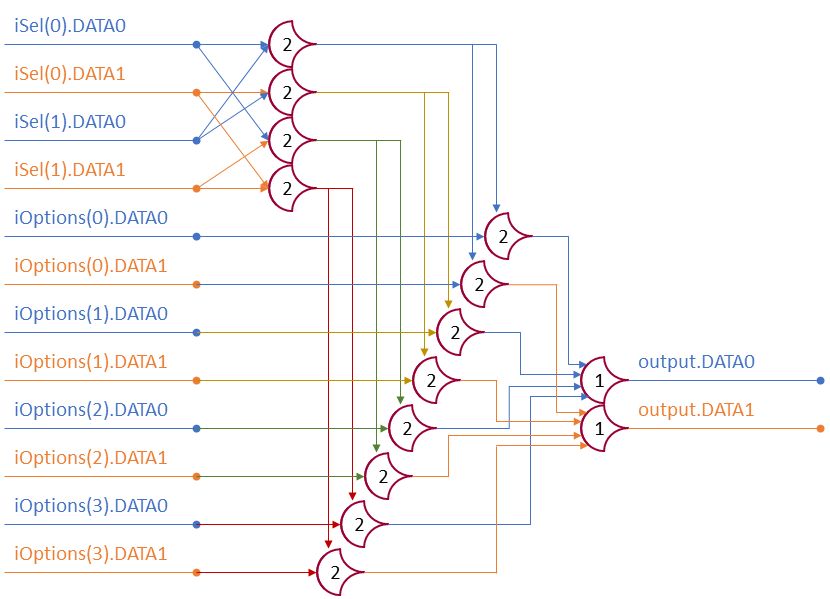
4-Option Example
for Case in 0 to N-1
[build CaseBits with DATA0's and DATA1's]
-- CaseBits is a concatenated signal from the iSelector input
Selectors(Case) <= THNN(CaseBits)
GatedCase0 <= TH22(Selectors(Case), iOptions(Case).DATA0)
GatedCase1 <= TH22(Selectors(Case), iOptions(Case).DATA1)
next Case
output.DATA0 <= TH1N(Gated00, Gated10, Gated20, Gated30, ...)
output.DATA1 <= TH1N(Gated01, Gated11, Gated21, Gated31, ...)
Generic pseudo-VHDL
Implementation
Remember the Full Adder‘s un-optimized version? If you look at the implementation, you’ll see a chunk of code at the top that generates one-hot encoding of all cases. We are going to use that for our internal Selectors signal:
cases: for case in 0 to NumOptions generate
bits: for ibit in 0 to NumSelectors-1 generate
Input0Selection: if (to_unsigned(2**iBit, 3) and to_unsigned(case, 3)) = 0 generate
selectorInputs(case)(iBit) <= iOptions(case).DATA0;
end generate;
Input1Selection: if (to_unsigned(2**iBit, 3) and to_unsigned(case, 3)) > 0 generate
selectorInputs(case)(iBit) <= iOptions(case).DATA1;
end generate;
end generate;
CaseSelectorGate: THmn
generic map(M => NumSelectors, N => NumSelectors)
port map(inputs => selectorInputs(case),
output => Selectors(case));
end generate;
Next, we need to gate the two lines (DATA0 and DATA1) for each option, which will NULL them if they are not the selected signal:
cases: for case in 0 to NumOptions generate
bits: for ibit in 0 to NumSelectors-1 generate
Input0Selection: if (to_unsigned(2**iBit, 3) and to_unsigned(case, 3)) = 0 generate
selectorInputs(case)(iBit) <= iOptions(case).DATA0;
end generate;
Input1Selection: if (to_unsigned(2**iBit, 3) and to_unsigned(case, 3)) > 0 generate
selectorInputs(case)(iBit) <= iOptions(case).DATA1;
end generate;
end generate;
CaseSelectorGate: THmn
generic map(M => NumSelectors, N => NumSelectors)
port map(inputs => selectorInputs(case),
output => Selectors(case));
Gated0: THmn
generic map(M => 2, N => 2)
port map(inputs(0) => Selectors(case),
inputs(1) => iOptions(case).DATA0,
output => GatedOptions0(case));
Gated1: THmn
generic map(M => 2, N => 2)
port map(inputs(0) => Selectors(case),
inputs(1) => iOptions(case).DATA1,
output => GatedOptions1(case));
end generate;
Finally, take all those gated options and or the signals together, so whichever one is selected will drive the line to a 1 if it is set:
cases: for case in 0 to NumOptions generate
bits: for ibit in 0 to NumSelectors-1 generate
Input0Selection: if (to_unsigned(2**iBit, 3) and to_unsigned(case, 3)) = 0 generate
selectorInputs(case)(iBit) <= iOptions(case).DATA0;
end generate;
Input1Selection: if (to_unsigned(2**iBit, 3) and to_unsigned(case, 3)) > 0 generate
selectorInputs(case)(iBit) <= iOptions(case).DATA1;
end generate;
end generate;
CaseSelectorGate: THmn
generic map(M => NumSelectors, N => NumSelectors)
port map(inputs => selectorInputs(case),
output => Selectors(case));
Gated0: THmn
generic map(M => 2, N => 2)
port map(inputs(0) => Selectors(case),
inputs(1) => iOptions(case).DATA0,
output => GatedOptions0(case));
Gated1: THmn
generic map(M => 2, N => 2)
port map(inputs(0) => Selectors(case),
inputs(1) => iOptions(case).DATA1,
output => GatedOptions1(case));
end generate;
o0: THmn
generic map(M => 1, N => NumOptions)
port map(inputs(0) => GatedOptions0(case),
output => output.DATA0);
o1: THmn
generic map(M => 1, N => NumOptions)
port map(inputs => GatedOptions1(case),
output => output.DATA1);
That’s all the logic then, but we need to add the wrapping structures (entity declaration, architecture declaration, and internal signal declarations). This module will have one generic parameter (NumOptions), and a constant based on it (NumSelectors). The width of the iSelector input will be the log of the number of options:
entity MUX is
generic(NumOptions : integer := 2);
port (iSelector : in ncl_pair_vector(0 to clog2(NumOptions)-1);
iOptions : in ncl_pair_vector(0 to NumOptions1-);
output : out ncl_pair);
end MUX;
architecture structural of MUX is
constant NumSelectors : integer := clog2(NumOptions);
signal Selectors : std_logic_vector(0 to NumOptions-1);
signal GatedOptions0 : std_logic_vector(0 to NumOptions-1);
signal GatedOptions1 : std_logic_vector(0 to NumOptions-1);
type SelectorData is array (integer range ) of std_logic_vector(0 to NumSelectors-1);
signal selectorInputs : SelectorData(0 to NumOptions-1);
begin
-- [This part is the same as before]
cases: for case in 0 to NumOptions generate
bits: for ibit in 0 to NumSelectors-1 generate
Input0Selection: if (to_unsigned(2**iBit, 3) and to_unsigned(case, 3)) = 0 generate
selectorInputs(case)(iBit) <= iOptions(case).DATA0;
end generate;
Input1Selection: if (to_unsigned(2**iBit, 3) and to_unsigned(case, 3)) > 0 generate
selectorInputs(case)(iBit) <= iOptions(case).DATA1;
end generate;
CaseSelectorGate: THmn
generic map(M => NumSelectors, N => NumSelectors)
port map(inputs => selectorInputs(case),
output => Selectors(case));
Gated0: THmn
generic map(M => 2, N => 2)
port map(inputs(0) => Selectors(case),
inputs(1) => iOptions(case).DATA0,
output => GatedOptions0(case));
Gated1: THmn
generic map(M => 2, N => 2)
port map(inputs(0) => Selectors(case),
inputs(1) => iOptions(case).DATA1,
output => GatedOptions1(case));
end generate;
o0: THmn
generic map(M => 1, N => NumOptions)
port map(inputs(0) => GatedOptions0(case),
output => output.DATA0);
o1: THmn
generic map(M => 1, N => NumOptions)
port map(inputs => GatedOptions1(case),
output => output.DATA1);
end structural;
Testing
I am testing this module with 2 inputs for now; in theory it scales, but at some point I should add a 4-option test, and maybe a 5 to see how it does with non-power of 2 values. The test script goes through the inputs options and tests that they output correctly.
When I first ran this, I had an error where the outputs indexing was in the wrong order. I had the part of the code near the top messed up to use iSelectors(case).DATA0 instead of DATA1 and vice versa.

Commit: b35b729
